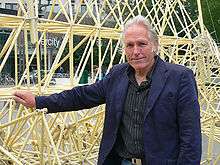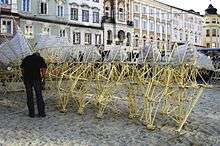Theo Jansen
| Theo Jansen | |
|---|---|
 Jansen in 2007 | |
| Born |
14 March 1948 Scheveningen, Netherlands |
| Nationality | Dutch |
| Occupation | Artist |
| Known for | Kinetic sculpture |
Theo Jansen (Dutch pronunciation: [ˈteːjoː ˈjɑnsə(n)]; born 14 March 1948) is a Dutch artist. In 1990, he began building large mechanisms out of PVC that are able to move on their own, known only as Strandbeest. The kinetic sculptures appear to walk.[1] His animated works are intended to be a fusion of art and engineering, and he has said that "The walls between art and engineering exist only in our minds." He strives to equip his creations with their own artificial intelligence so they can avoid obstacles such as the sea by changing course when one is detected.
Early life
Jansen was born in Scheveningen in the Netherlands. He grew up with a talent for both physics and art, and studied physics at the University of Delft. Jansen left the University in 1974 without a degree.[2] While at Delft, Jansen was involved in many projects that involved both art and technology, including a paint machine and a UFO.
UFO
In 1979 Jansen started using cheap PVC pipes to build a 4-meter wide flying saucer that was filled with helium. It was launched over Delft in 1980 on a day when the sky was hazy. Light and sound came from the saucer. Because the saucer was black against a light sky, its size was hard to guess. The police even said it was 30 meters wide and some people swore they saw a halo around it. Jansen has claimed that this project "caused a near-riot".[3] He said that they never found the UFO, and that it had probably landed somewhere in Belgium.[3] He later redid the project over Paris.
Painting machine
Jansen's painting machine was developed in 1984–86 in Delft, and was a somewhat bigger project than his UFO. It consisted of a tube with a light cell situated at its end, which when darkness 'hit' it would start spraying. This created paintings of the silhouettes of the people who were standing in front of it. This machine was attached to a large piece of wood and hoisted against a wall where it would move back and forth and create 2D images of everything in the room.[4]
The Strandbeest


Jansen has been creating Strandbeest (Dutch: strand=beach; beest=beast), wind-walking examples of what Jansen suggests is a kind of artificial life, since 1990. What was at first a rudimentary "breed" has slowly evolved with the aid of evolutionary computation techniques[5] into a generation of machines that to some degree are able to react to their environment: "over time, these skeletons have become increasingly better at surviving the elements such as storms and water, and eventually I want to put these animals out in herds on the beaches, so they will live their own lives."
Constructed from PVC piping, wood, and fabric airfoils, Jansen's creations are constantly being improved and are designed to function in the sandy beach environment in which Jansen releases them. The creations are also able to store air pressure and use it to drive themselves in the absence of wind.[6] Jansen's more sophisticated creations are able to detect once they have entered water and walk away from it, and one model is capable of anchoring itself to the earth if it senses a storm approaching.
References
- ↑ Jansen, Theo. "Theo Jansen | Speaker | TED.com". www.ted.com. Retrieved 2016-04-09.
- ↑ Solnit, Rebecca. "The March of the Strandbeests". The New Yorker. Retrieved 2016-10-13.
- 1 2 "Strandbeest". Strandbeest. Retrieved 2013-06-13.
- ↑ "Strandbeest". Strandbeest. Retrieved 2016-10-13.
- ↑ Jansen, Theo. "leg system". strandbeest.com. Retrieved 2016-05-15.
- ↑ Macdonald, Fiona. "Theo Jansen's Strandbeests: Wind-powered skeletons". www.bbc.com. Retrieved 2016-04-09.
External links
| Wikimedia Commons has media related to Theo Jansen. |
- Strandbeest.com – website with video and photos of the animals
- Strandbeest.es – website with video and photos of the animals in Spanish
- Strandbeestmovie.com – documentary film about Theo Jansen by Alexander Schlichter – The website is a workbook with videos and pictures.
- Theo Jansen at TED

- Jansen, Theo. "Man creates kinetic sculpture that moves and lives on its own". Kinetic Sculpture. BBC Radio One. Retrieved January 27, 2011.
- SiouxWIRE interview – SiouxWIRE interview with Theo Jansen (April 2008)
- Real-time 2D simulation of Jansen's sculpture using the APE physics engine
- Strandbeest: Theo Jansen from Art Futura, 2005
- Video of Theo Jansen at Art Futura 2005 on YouTube
- Theo Janssen Machine in Mathcad on PlanetPTC